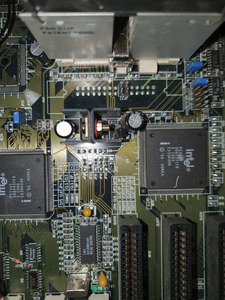First post, by Skip94
Hi all, fairly new here, but recently got back into tinkering with old PC's after a bit of a break. A friend of mine gave me one of his old computers, that he still had sat in the loft. Its a Pentium 166 system, came to me with 40MB of RAM, originally 8MB. 1.2GB Seagate drive with a really messy install of W95 on it.
I've done a bit of work on it, upgraded it to 64MB of RAM, changed out the original Cirrus Logic video card for a Matrox Mystique I had laying about and also added a sound, USB and Ethernet. Then did a fresh install of W95 onto a 4GB CF card.
One thing I did rather want to do is to swap out the CPU for a Pentium 200MMX. The Motherboard is a labelled as a P5I437P4/FMB, which also seems to have been called a 430FXFMB. Seems to have been made by QDI, but it doesn't seem to be too common a board.
It seems to have been released before the MMX range of Pentium CPU's, but does have a pair of jumpers to drop the core voltage from 3.3V to 2.5V that I believe the earliest MMX CPU's ran at. It also has jumper settings to set the frequency anywhere up to 200MHz.
So... I bought a 200MMX CPU on ebay, as I've read online that a lot of these later 2.8V processors will run just fine at a lower voltage and sure enough it does seemingly fine. However, if I set the jumpers for 200MHz, the bios and CPUZ both report it running at 166MHz. I initially assumed this was just a fault with the board, but if I put the original 166 non MMX back in, I can happily clock that up to 200MHz, no issues.
Same thing happens with a 233MMX I also have, so I don't think its a CPU issue.
Is this a known issue with trying to run a later MMX CPU in an early board, or is there a known workaround?
Cheers
Andrew
